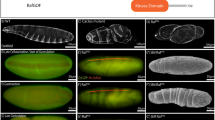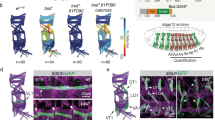Abstract
The JAK/STAT signal transduction pathway has been conserved throughout evolution such that true structural and functional homologues of components originally identified in vertebrate systems are also present in the model genetic system Drosophila melanogaster. In addition to roles during larval hematopoiesis reminiscent of the requirement for this pathway in mammalian systems, the JAK/STAT pathway in Drosophila is also involved in a number of other developmental events. Recent data has demonstrated further roles for the JAK/STAT pathway in the establishment of sexual identity via the early embryonic expression of Sex lethal, the segmentation of the embryo via the control of pair rule genes including even skipped and the establishment of polarity within the adult compound eye via a mechanism that includes the four jointed gene. Use of the powerful genetics in the model organism Drosophila may identify new components of the JAK/STAT pathway, define new roles for this pathway, and provide insights into the function of this signal transduction system. Here we review the roles of STAT and its associated signaling pathway during both embryonic and adult stages of Drosophila development and discuss future prospects for the identification and characterization of novel pathway components and targets.
This is a preview of subscription content, access via your institution
Access options
Subscribe to this journal
Receive 50 print issues and online access
$259.00 per year
only $5.18 per issue
Buy this article
- Purchase on SpringerLink
- Instant access to full article PDF
Prices may be subject to local taxes which are calculated during checkout



Similar content being viewed by others
References
Barillas MC, Han YS, Seeley D and Kafatos FC . 1999 EMBO J 18: 959–967
Binari R and Perrimon N . 1994 Genes Dev 8: 300–312
Brodsky MH and Steller H . 1996 Dev Biol 173: 428–446
Cho K-O and Choi K-W . 1998 Nature 396: 272–276
Chou TB and Perrimon N . 1996 Genetics 144: 1673–1699
Chung CD, Liao J, Liu B, Rao X, Jay P, Berta P and Shuai K . 1997 Science 278: 1803–1805
Cline TW . 1993 Trends Genet 9: 385–390
Darnell JE . 1997 Science 277: 1630–1635
Domínguez M and de Celis JF . 1998 Nature 396: 276–278
Gabay L, Seger R and Shilo BZ . 1997 Science 277: 1103–1106
Hanratty WP and Dearolf CR . 1993 Mol Gen Genet 238: 33–37
Harrison DA, Binari R, Nahreini TS, Gilman M and Perrimon N . 1995 EMBO J 14: 2857–2865
Harrison DA, McCoon PE, Binari R, Gilman M and Perrimon N . 1998 Genes Dev 12: 3252–3263
Heberlein U, Borod E and Chanut F . 1998 Development 125: 567–577
Hou XS, Melnick MB and Perrimon N . 1996 Cell 84: 411–419
Juni N, Awasaki T, Yoshida K and Hori SH . 1996 Genetics 143: 1257–1270
Liu X, Quinn AM, Chin YE and Fu XY . 1999 Science 285: 167a
Luo H, Asha H, Kockel L, Parke T, Mlodzik M and Dearolf CR . 1999 Dev Biol 213: 432–441
Luo H, Hanratty WP and Dearolf CR . 1995 EMBO J 14: 1412–1420
Luo H, Rose P, Barber D, Hanratty WP, Lee S, Roberts TM, D'Andrea AD and Dearolf CR . 1997 Mol Cell Biol 17: 1562–1571
Mathey-Prevot B and Perrimon N . 1998 Cell 92: 697–700
Mesilaty-Gross S, Reich A, Motro B and Wides R . 1999 Gene 231: 173–186
Mohr SE and Boswell RE . 1999 Gene 229: 109–116
Nicholson SE, Willson TA, Farley A, Starr R, Zhang JG, Baca M, Alexander WS, Metcalf D, Hilton DJ and Nicola NA . 1999 EMBO J 18: 375–385
Papayannopoulos V, Tomlinson A, Panin VM, Rauskolb C and Irvine KD . 1998 Science 281: 2031–2034
Perrimon N and Mahowald AP . 1986 Dev Biol 118: 28–41
Small S, Blair A and Levine M . 1996 Dev Biol 175: 314–324
Sweitzer SM, Calvo S, Kraus MH, Finbloom DS and Larner AC . 1995 J Biol Chem 270: 16510–16513
Takeshita T, Arita T, Higuchi M, Asao H, Endo K, Kuroda H, Tanaka N, Murata K, Ishii N and Sugamura K . 1997 Immunity 6: 449–457
Venderosa FJ and Muller HJ . 1954 Genetics 39: 999
Villano JL and Katz FN . 1995 Development 121: 2767–2777
Wehrli M and Tomlinson A . 1998 Development 125: 1421–1432
Williams JG . 1999 Trends Biochem Sci 24: 333–334
Wolff T and Ready DF . 1993 The Development of Drosophila melanogaster Bate M and Martinez-Arias A eds Cold Spring Harbor Press Cold Spring Harbor pp 1277–1326
Yan R, Small S, Desplan C, Dearolf CR and Darnell JJ . 1996a Cell 84: 421–430
Yan R, Luo H, Darnell JJ and Dearolf CR . 1996b Proc Natl Acad Sci USA 93: 5842–5847
Zeidler MP, Perrimon N and Strutt DI . 1999a Curr Biol 9: 1363–1372
Zeidler MP, Perrimon N and Strutt DI . 1999b Genes Dev 13: 1342–1353
Acknowledgements
The authors would like to thank Thomas Cline, Henry Sun and David Strutt for sharing results prior to publication, Eric Spana for Drosophila genome project sequence searches, and Susan Smith for comments on the manuscript. MP Zeidler is a Leukemia Society of America Special Fellow, EA Bach is a Fellow of The Jane Coffin Childs Fund for Medical Research and N Perrimon is an Investigator of the Howard Hughes Medical Institute.
Author information
Authors and Affiliations
Rights and permissions
About this article
Cite this article
Zeidler, M., Bach, E. & Perrimon, N. The roles of the Drosophila JAK/STAT pathway. Oncogene 19, 2598–2606 (2000). https://doi.org/10.1038/sj.onc.1203482
Published:
Issue Date:
DOI: https://doi.org/10.1038/sj.onc.1203482



